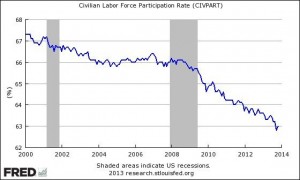The unemployment rate has been declining, but so has labor force participation. Media attention tends to focus on the former and to ignore the latter; as a result, some people wrongly assume that the employment situation is improving and that it’s only a matter of time before things get back to “normal.” Here are some sobering facts.
The November 2013 Labor Department report shows a clear decline in both unemployment and labor participation. While the economy added more jobs than expected –incidentally, largely in the low-wage retail and leisure sectors- more people dropped out of the workforce altogether. In all, 91.5 million people of working age –37.2% of the labor force- are not working. At this rate, they will surpass the number of workers in about four years.
There are several reasons for this, all negative. While some baby boomers will have non-government income from retirement savings, that will require selling securities. If the number of sellers exceeds the number of buyers, asset prices may decline. If that happens some may be forced to sell even more, triggering a nightmarish cycle. And that’s not all. Generally, people on fixed incomes budget more and spend less, bad for local businesses –but not quite as crucial for multi national corporations- and the government, whose revenue stands to decline accordingly.
Speaking of taxes, safety-net programs such as welfare, food stamps and the new medical insurance program, as well as the military, need lots of taxation to support them; if tax receipts decline, the government will have to decide, gridlock permitting, whether to accelerate the rate of deficit spending, cut expenditures, increase tax rates, or some combination thereof. In any event, the trend does not herald better times ahead, particularly for working class people. We need a new, powerful incentive to get back to work.
